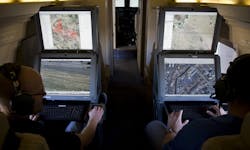Air Force picks SSi for work in mid-wave infrared event-based cameras for future persistent awareness
WRIGHT-PATTERSON AFB, Ohio – U.S. Air Force researchers needed event-based cameras to sense mid-wave infrared (MWIR) light signals for future applications in moving target detection. They found a solution from Sensing Strategies Inc. (SSi) in Pennington N.J.
Officials of the Multispectral Sensing & Detection Division of the Air Force Research Laboratory Sensors Directorate at Wright-Patterson Air Force Base, Ohio, announced a $900,070 contract to SSi last week for part of the Multi-Spectral Sensing Technologies R&D (MuSTeR) program.
An event-based camera responds to local changes in brightness; they do not capture images using a shutter like conventional cameras. Each pixel inside an event camera operates independently and asynchronously b reporting changes in brightness as they occur.
Mid-wave infrared sensors cover the light wavelengths ranging from three to five microns to detect and observe the radiant heat that uncooled thermal-imaging cameras see.
Related: The next frontier of electro-optical sensors
MuSTeR seeks to enhance the state-of-the-art in U.S. military sensor system research by using the entire electromagnetic spectrum to deliver next-generation capabilities for global persistent awareness.
MuSTeR is developing infrared search and track (IRST) technology, for example, to enable U.S. and allied aircraft to search for airborne targets without giving away their presence by emitting RF and microwave energy.
The project also focuses on improved RF sensing systems for situational awareness and targeting applications, as well as developing an advanced large-format high-dynamic-range long wave infrared (LWIR) digital pixel readout integrated circuit (DPROIC) for airborne infrared and track (IRST) applications.
Other MuSTeR contractors are looking into low-cost infrared search and track (LC-IRST) system design tradeoffs, cloud clutter suppression algorithms and processing, and machine learning techniques with the potential to improve overall IRST detection performance.
Other focus areas of the MuSTeR program include multiband multifunction radio frequency sensing; laser radar technology; passive radio frequency sensing; and distributed radio frequency sensing.
SSi joins other MuSTeR contractors, which include Radial Research & Development Ltd in Fairborn, Ohio; Northrop Grumman Mission Systems segment in Linthicum, Md.; Applied Signals Intelligence Inc. in Sterling, Va; BlackHorse Solutions Inc. in Herndon, Va.; SRI International in Menlo Park, Calif.; and Senseeker Engineering Inc. in Santa Barbara, Calif.
For more information contact Sensing Strategies Inc. online at www.sensingstrategies.com, or the Multispectral Sensing & Detection Division of the Air Force Research Laboratory Sensors Directorate at www.afrl.af.mil/About-Us/Fact-Sheets/Fact-Sheet-Display/Article/2332214/afrlrym-multispectral-sensing-detection-division.
About the Author
John Keller
Editor-in-Chief
John Keller is the Editor-in-Chief, Military & Aerospace Electronics Magazine--provides extensive coverage and analysis of enabling electronics and optoelectronic technologies in military, space and commercial aviation applications. John has been a member of the Military & Aerospace Electronics staff since 1989 and chief editor since 1995.
